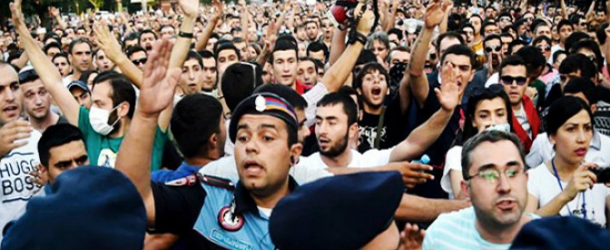Pushed by Russia’s ”InterRAO” company the ”Electric Networks of Armenia” (ENA) has proposed a price increase for the electricity and the government was expected to adopt a decision approving a 16.7 percent hike as of 1 August. The reason for the tariff increase is corruption and mismanagement within the ENA that led to the accumulation of $250 million debt. The decision sparked protests in the capital city of Yerevan that took place on 19-30 June under the theme of ”No to Plunder”. The InterRAO owns 100 percent stake in the ENA. Despite that proposition of price increase came from the Russian company, the protesters insisted that resentment was aimed not against Russia and the goal was to force the government to rescind its decision. Although the sit-ins ended, the protesters are vowing to continue the opposition movement.
Social-Economic Catalysts to Protests
Albeit Armenia lacks strong opposition, the protest movement enduring for long and oftentimes attracting some fifteen thousand people pointed to the fact that there were underlying social, economic and moral factors. The one-thirds of the population lives below the poverty line. As if unemployment, monopolism and corruption was not enough, the annual tariff increase in utilities, such as natural gas and electricity, makes the life of the people more measurable.
Therefore, it is no coincidence that Armenia has a combustible social environment that is ready to implode. Another noteworthy aspect is the active involvement of the youth in the protest movement; they are viewed as the driving force. The youth protests not just against the socioeconomic grievances, but also the country’s orientation. The polls suggest that the Armenian youth is gradually becoming more pro-Western. Moreover, Armenia’s membership in the Customs Union offers no dividends to the country and 30 percent decrease in the import of goods is attributed to this alignment. This only adds to the dismay in the society caused by the Sargsyan regime’s choice of rejecting deeper engagement with the European Union.
It must be noted that Armenia has seen protests against the price increase in the past. This time around, however, it is different. A significantly higher number of protesters, active involvement of the youth, the murder of an entire seven member family in Gyumri by Russian military serviceman Valeriy Permyakov in January 2015 and finally, the visit by Kim Kardashyan’s family to Armenia and Yerevan performance by Kanye West has created a special atmosphere in the society and bolstered the desire for change.
In the meantime, the consolidation within the civil entities and NGO’s in Armenia, the successful outcome of systematic and consistent protest actions against the government’s price increase and compulsory pension reforms and propagation and dissemination of information through the social networks have been the trending features lately. Therefore, these rallies demonstrate a strong civil opposition shaped against incompetent policies of Armenia’s leadership.
Postmodern Undertones of Protests in Armenia
The form, mechanism and organization techniques of the protest movement against the electricity tariff rise in Armenia are notable for their postmodern features. One of the postmodern examples was ”tested” in the U.S. before. ‘Occupy’ movement was without a leader, organizational structure, a clear system of ideals, conduct and action principles or even clear objectives. Some of these features also emerged during Turkey’s ”Gezi Park” developments and Hong Kong’s ”Umbrella Movement”. Color revolutions and ”Maydan” movement is among the elements encapsulating postmodern protest.
Although, on the surface, these movements may appear chaotic, precision and consistency in the organization of protests, the movement swiftly alluring more participants, cautious and composed posture while engaging the authorities and well-managed performance attests to rigorous oversight from outside. These type of movements usually have no distinctive leader (or leaders) and even if they do, it is not charismatic and powerful one, perhaps more of a ”first among equals”, with horizontal and not vertical ‘chain of command’.
According to some experts, the absence of a strong and influential leader makes the movement easier to direct from abroad. Such methods as sit-ins and the occupation of public spaces, demonstration of the peaceful nature of the protest, financial and moral backing of the protesters and using entertainment options to lure the protesters were the ones employed in Armenia as well. Among other examples of postmodernist protest options are small-scale theatrical and show style events dedicated to environmental protection and defending of animals’ rights.
Protests in Armenia also demonstrated that maintaining large crowds in the main squares and avenues of the capital city is doable even without a certain political ideology, leadership and superstructure. Some believe that it was erroneous for the ”No to Plunder” movement not to nominate a leader and politicize the issue and contend that the movement’s demise is inevitable. Perhaps, the movement participants have either not set political goals or realized they would be unattainable for the time being. That said, ten days- long rallies could be a rehearsal for larger and more crucial protests. The time will tell.
Attitude of the West and Russia
Nevertheless, Sargsyan’s government panicked in the face of the protests. Several skirmishes between the police and protesters, use of force against the demonstrators, violent crowd dispersal that left journalists detained and cameras and other equipment destroyed were among the cases registered. It was fascinating; regardless of police brutality, the U.S. and British Embassies’ reaction was limited to statements of praise rather than denouncement, and the likes of CNN, BBC, Guardian, Independent, Amnesty International, Human Rights Watch and Freedom House remained silent. In line with the tradition, a blind eye was turned to the violation of human rights in Armenia once again.
It is no secret that the protests in Armenia troubled Russia, just as they worried Sargsyan’s regime. In general, almost every anti-government protest in Armenia is depicted by the Russian media as ”color revolution” attempt by the West and especially the U.S., aimed at undermining Russia’s influence. Konstantin Kosachev, Chairman of Foreign Affairs Committee of Russia’s Council of Federation also described the protests as part of the Western scenario for ”color revolution”. Overall, the ”electric” movement, distinctive for its scale and persistence, captured Russian media’s attention from the day one and many analysts pointed out Western involvement in the protests in Armenia.
Being Russia’s fulcrum in the South Caucasus and totally dependent on the former, Armenia’s downfall would imply the demise of Russia’s competitiveness in the geopolitical rivalry with the West. Therefore, it is not unlikely that compared to the events in Ukraine, Russia might display a more aggressive stance to the trend of Armenia drifting away from its orbit of influence. For the moment, the Kremlin, being not so apprehensive of the situation, chose to provide a $200 million preferential loan to Armenia and pledged to allow Permyakov’s court case to take place in Armenia.
Thus, it is inconceivable that Armenian authorities would hence conduct a different domestic and foreign policy and tackle socioeconomic grievances. Social discontent is likely to grow under such circumstances. Even if a revolution were to take place, the change of the political course would still be questionable. The society in Armenia finds itself in a predicament. Such a situation would be conducive to enduring social tensions, mass demonstrations and frequent derailing of stability. It cannot be ruled out that the political circles in the West would capitalize on that to undermine Russia’s position in the region or at least cause extra headache for Moscow.
























































